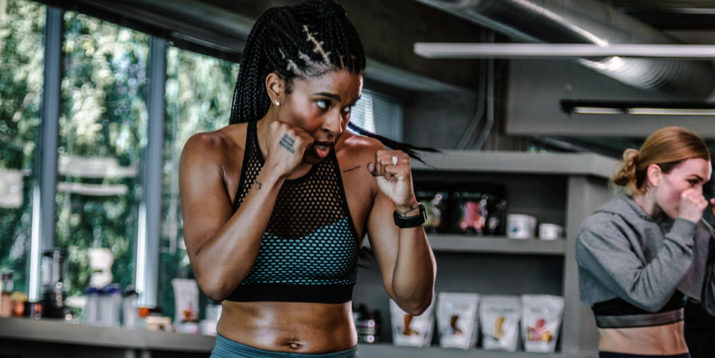How to Throw a Punch

Knowing how to throw a punch is one of those necessary life skills you hope you never need to use in an everyday situation.
(We put hand-to-hand combat somewhere between changing a flat tire and performing the Heimlich maneuver.)
But even if you’re a total pacifist, it’s worth your time to learn how to punch, as it will open up a world of new exercise options.
Boxing and kickboxing are incredibly effective workouts for elevating your heart rate, burning calories and strengthening your core.
They’re scalable for every level of experience and fitness; advanced athletes can work on their speed and combinations while beginners master foundational movements.
And one of the most important basics is learning how to throw a proper punch.
1. Assume a Boxing Stance
Learning how to throw a good punch starts from the ground up, says Tatiana Firpo, CPT, and instructor for beRevolutionarie, a digital wellness, fitness, and mindfulness platform for women.
One foot (dominant) should be staggered behind the other. “Always keep your feet a little wider than hip-distance apart. Never allow your back foot to cross behind or end up directly behind your front foot (for balance),” she says. “Your dominant side should be far away from the bag [or opponent — real or imaginary] and the less dominant closest.”
Bend your knees slightly.
Bring your hands up to your face, just below your eyes, and tuck in your elbows.

2. Make Two Fists
Curl the tips of your fingers in toward the center of your palm. Wrap your thumb over and behind the index and middle fingers — never wrap your fingers around your thumb.
Align your wrist with your forearm so that there’s a straight line from your elbow crease to your knuckles.
If you’re sparring with an opponent or using a punching bag, “not locking your wrist straight into position can result in injury to the ligaments and tendons of the wrist,” says Jason Salter, certified personal trainer, boxing/kickboxing instructor, and co-owner of Forged Soul Fitness in Berlin, New Jersey.
A program like 10 Rounds, which features shadowboxing, is a great way to get the benefits of a boxing workout — without actually having to hit anything (or anyone).
3. Strike

Anyone who knows how to throw a hard punch understands that it’s a full-body movement that draws power from the core and hips.
The cross, which uses your dominant hand, relies heavily on the body’s rotational force.
“Start by pivoting the back foot (heel up). The hip and shoulder follow in the rotation,” Firpro says. “Keep your elbow in [don’t swing your arm out to the side] as you extend your arm straight and twist your fist so that the palm is facing the ground. Return your hand to face your face faster than it went out.”
As you throw a punch, exhale. People tend to hold their breath while exerting force, Salter explains, so exhaling with each strike will force you to breathe.
“If you’re sparring it prevents you from getting the wind knocked out of you, and it also keeps you in control of your breathing,” he says.
To protect your hand and make the greatest impact, aim to land punches where your knuckles are flush with the bag.
If your knuckles aren’t flush, you run the risk of damaging some of the structures in your hand.
4. Return to a Boxing Stance
Between punches, return to your boxing stance, and keep your hands up.
“As people fatigue, they drop their hands. So when they do punch, they have to lift their hands first and then throw the punch,” Salter says. “Keeping your hand up eliminates the time needed to raise your hand before throwing the punch, cutting down the time to throw the punch and making it more efficient and effective.”
